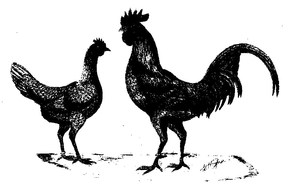Proposed Breed Standard for the Ayam Cemani in the UK

AYAM CEMANI
LARGE FOWL
Origin: Indonesia
Classification: Rare
Egg Colour: White or tinted
The Cemani fowl originates from the Indonesian archipelago. In 1998, the first examples came to the Netherlands, and in 2008 to Britain. There is some variety in type, but most look rather gamey, and all have single combs. The main characteristic of the breed is the intense black feather colour in combination with black skin colour, including face, earlobe and comb. Black skinned fowl are valued in many Asian countries for eating in ceremonial traditions.
General Characteristics: male
Type and Carriage: General appearance alert and quite gamey.
Body: medium sized, slim, firm and muscular, wings held strongly to body. Alert bearing
Breast: fairly broad, full and firm.
Back: back medium length, sloping from the neck; saddle hackle rather short.
Wings: long, large and strong, held slightly high at the shoulders. held tight to the body, and not resting on the back. Shoulders – wide and firm.
Tail: held a little high; moderate spread with narrow, medium length sickles. Rump - moderately developed. Parson’s Nose small, and firm, little fluff.
Head: of medium size. Face – black and smooth. wattles medium, small black earlobes, eyes large and full of expression, dark brown to black with black pupils. Comb – single, usually with five points, black. Back of comb not following down the line of the neck. Beak – firm, well curved, black.
Neck: long and firm; the neck hackle reaching to the shoulders.
Legs and Feet: Thighs medium, powerful, set well apart, good bend of hock. Straight parallel medium length shanks - black. Four toes long, strong and well spread, with prop toe standing well back and firm on the ground – black. Well-developed spurs in mature male birds
Plumage: Feathers quite short and close-fitting
Handling: Firm and muscular.
Female
The general characteristics are similar to those of the male, allowing for natural sexual differences. The back line of the hen can be less angled, the face is often a more intensive black.
Colour
Plumage – Black. Green sheen is not so obvious as in some black breeds. Skin, face, comb and legs – Black.
Weights
Male 1.8–2kg (approx 4–4½lbs)
Female 1.2-1.5kg (approx 2¾-3½lbs)
Ring Sizes: Cock 18mm (E18) Hen 16mm (D16)
Scale of Points
Feather Colour 20
Skin Colour 30
Type 15
Legs and feet 10
Head 10
Condition 15
Serious defects
Carriage too horizontal. Tail carriage too high or too low. Wings hanging down. Legs too short. Too little black pigment in the skin colour.
LARGE FOWL
Origin: Indonesia
Classification: Rare
Egg Colour: White or tinted
The Cemani fowl originates from the Indonesian archipelago. In 1998, the first examples came to the Netherlands, and in 2008 to Britain. There is some variety in type, but most look rather gamey, and all have single combs. The main characteristic of the breed is the intense black feather colour in combination with black skin colour, including face, earlobe and comb. Black skinned fowl are valued in many Asian countries for eating in ceremonial traditions.
General Characteristics: male
Type and Carriage: General appearance alert and quite gamey.
Body: medium sized, slim, firm and muscular, wings held strongly to body. Alert bearing
Breast: fairly broad, full and firm.
Back: back medium length, sloping from the neck; saddle hackle rather short.
Wings: long, large and strong, held slightly high at the shoulders. held tight to the body, and not resting on the back. Shoulders – wide and firm.
Tail: held a little high; moderate spread with narrow, medium length sickles. Rump - moderately developed. Parson’s Nose small, and firm, little fluff.
Head: of medium size. Face – black and smooth. wattles medium, small black earlobes, eyes large and full of expression, dark brown to black with black pupils. Comb – single, usually with five points, black. Back of comb not following down the line of the neck. Beak – firm, well curved, black.
Neck: long and firm; the neck hackle reaching to the shoulders.
Legs and Feet: Thighs medium, powerful, set well apart, good bend of hock. Straight parallel medium length shanks - black. Four toes long, strong and well spread, with prop toe standing well back and firm on the ground – black. Well-developed spurs in mature male birds
Plumage: Feathers quite short and close-fitting
Handling: Firm and muscular.
Female
The general characteristics are similar to those of the male, allowing for natural sexual differences. The back line of the hen can be less angled, the face is often a more intensive black.
Colour
Plumage – Black. Green sheen is not so obvious as in some black breeds. Skin, face, comb and legs – Black.
Weights
Male 1.8–2kg (approx 4–4½lbs)
Female 1.2-1.5kg (approx 2¾-3½lbs)
Ring Sizes: Cock 18mm (E18) Hen 16mm (D16)
Scale of Points
Feather Colour 20
Skin Colour 30
Type 15
Legs and feet 10
Head 10
Condition 15
Serious defects
Carriage too horizontal. Tail carriage too high or too low. Wings hanging down. Legs too short. Too little black pigment in the skin colour.
